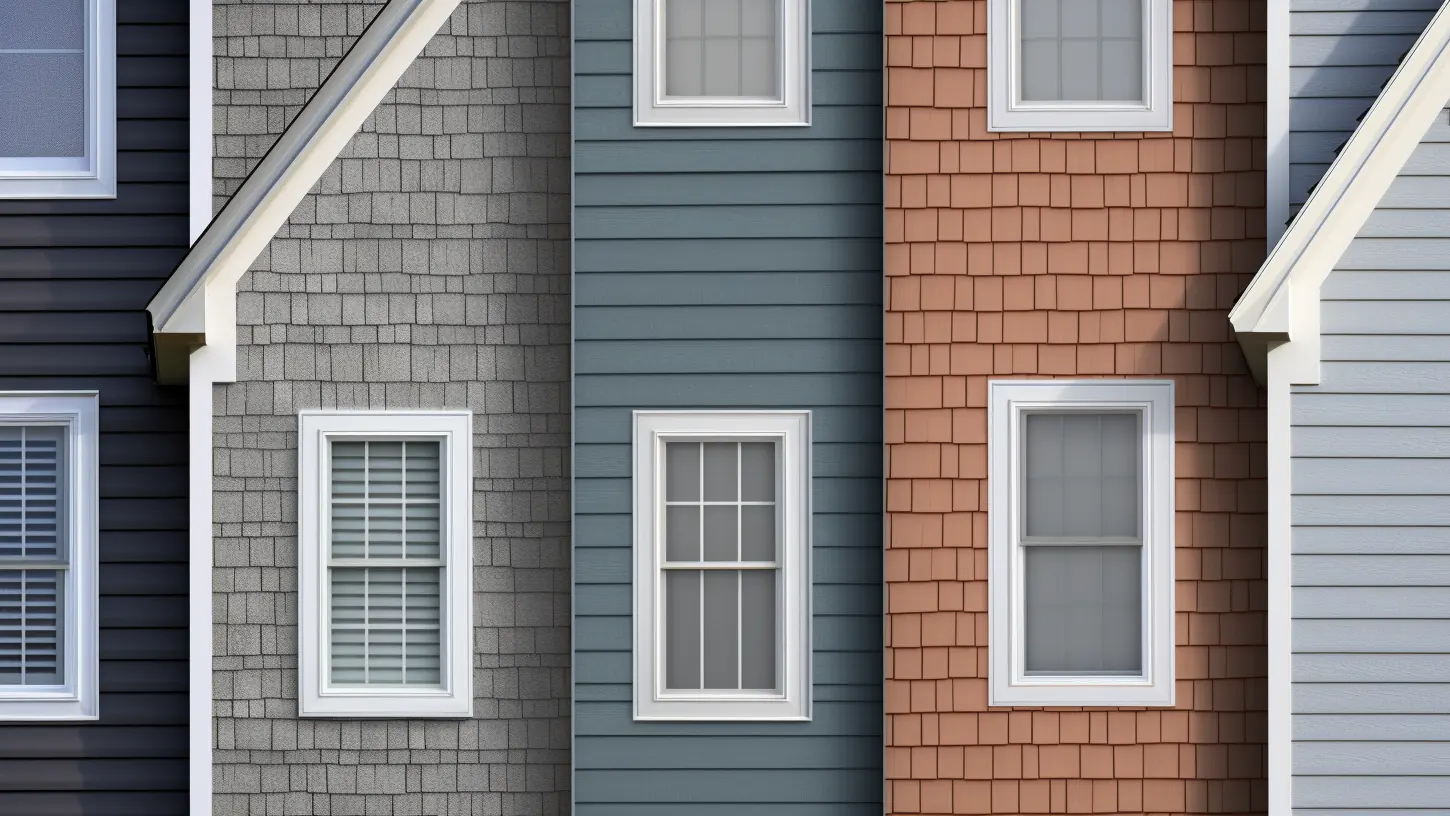Board and Batten Wood Si...
- Mon to Fri: 09:00 am to 07:00 pm

Vinyl siding is an affordable and low-maintenance solution to give your home a fresh new look. When it comes to choosing the perfect style for your home, there are a plethora of options to consider. Although there are many vinyl siding styles it is important to know what style you want and what will look best for your home.
In this post, we will go over the different types of vinyl siding styles, the pros, and cons of each siding style, and we will compare how these siding styles stand up against something like wood siding styles.
So, let’s take the time to explore the possibilities and find the perfect fit for your style and needs.
There are so many different types of vinyl siding. Over the years, vinyl siding has evolved into many different styles, shapes, and sizes while still being the same material. We have compiled a list of popular vinyl siding styles and other types of vinyl siding for you so finding the right vinyl siding style for your home will not be so hard.
There are 2 major styles that vinyl siding falls into and they are horizontal vinyl siding and vertical vinyl siding.

Board and batten siding, also called barn siding, is the first vinyl siding style on our list. Board and batten vinyl siding is a type of siding that consists of wide, flat boards that are spaced apart with narrow strips called battens.
The result is a timeless, rustic look that can add character to any home. The boards themselves can be horizontal or vertical, usually, homeowners use board and batten siding as vertical siding, but depending on your preference it can also be horizontal, and they are typically made of high-quality vinyl to ensure durability and long-lasting beauty.

Dutch lap vinyl siding is a popular choice among homeowners due to its aesthetic appeal and durability. This type of horizontal siding features a distinct profile that resembles an upside-down “T” shape. Each plank overlaps the one below it, creating a shadow effect that adds depth and texture to the facade of a home.
Its versatility also allows it to be customized to any architectural style, making it a reliable option for any home renovation or new construction project.

Traditional lap vinyl siding typically features long, thin panels with a horizontal overlap, creating a layered look similar to traditional wood clapboard siding. Lap vinyl siding comes in a wide variety of colors and styles, allowing homeowners to choose a look that perfectly complements the style and design of their home.
The versatile design of traditional lap vinyl siding makes it a popular choice for a range of architectural styles, from modern to traditional.

This type of siding offers a rustic and natural wood-like appearance that perfectly complements a range of home styles – from traditional to modern. Cedar shake siding typically features cedar shingles that appear to be hand-split and crafted from real cedar wood.
However, it offers many benefits over traditional wood, such as resistance to decay, insect damage, and moisture. Additionally, this type of siding is low-maintenance, making it an excellent investment for homeowners looking to enhance their home’s curb appeal without having to worry about frequent upkeep.

Insulated vinyl siding is made up of two layers of vinyl with a layer of insulation in between, providing extra protection against the elements and reducing the transfer of heat in and out of a home. When it comes to looks and style, insulated vinyl siding comes in a variety of colors and textures to match any home’s aesthetic.
Since insulated vinyl siding is very versatile in appearance homeowners can choose from smooth, wood grain, or even stone texture options for their siding. Additionally, some manufacturers offer profiles that mimic the look of traditional clapboard or shake siding for a more classic or rustic appearance.
Beaded vinyl siding is a type of vinyl siding that is designed with grooves or a beaded texture, that goes horizontally across the siding creating an appealing look that resembles that of traditional, high-end wooden siding.
It adds subtle detail to the exterior of a home, creating a more vibrant and stylish appearance. The beaded design not only enhances the overall aesthetic of the house but also creates a sense of depth and dimension, adding an element of sophistication to the exterior.

This type of siding is designed to mimic the appearance of traditional wooden logs while boasting all the advantages of modern vinyl. Log vinyl siding is both durable and low-maintenance, meaning that it will stand up to harsh weather and resist fading, rotting, or cracking.
It is available in a range of colors, styles, and textures, providing you with flexible design options to match any personal preference or the style of your home.
Wood grain vinyl siding is a popular option for homeowners looking to add an authentic wood appearance to their homes without the high maintenance and cost associated with real wood siding.
This type of siding is made from a durable and weather-resistant vinyl material that is designed to mimic the look and texture of the natural wood grain. Available in a range of colors and styles, wood grain vinyl siding can be customized to match the exterior of any home.
Its versatile design can offer homeowners the option to create a classic or more modern aesthetic, all while enjoying the benefits of a low-maintenance and cost-effective siding option.
How much does vinyl siding cost and does that change with the different styles? According to the Vinyl Siding Institute, the average price of vinyl siding for material and labor costs would be $393 per 100 square feet.
Comparing this to other siding materials such as fiber cement board siding which comes at an average price of $684, we have come to find that vinyl siding is a very affordable option for homeowners.
Real wood siding comes out to be even more expensive than the previous two options that were presented. Wood siding triples the price of vinyl siding at an average price of $1389.

Choosing the right style of vinyl siding for your home is a decision made out of preference. Consider the aesthetic and design that you want your home to have, as well as the local climate.
Do research on styles of vinyl siding and find ones that meet your needs both aesthetically and functionally. You may also want to consult with a professional siding contractor who can provide advice on what options are available for your particular situation.
Vinyl siding is very durable and can last up to 40 years or more with maintenance. It is also highly resistant to fading, staining, cracking, and other damage from the elements. Compared to wood siding which can easily be damaged by moisture, pests, and extreme weather conditions, vinyl siding has a much longer lifespan. Aluminum siding may be more durable than wood, but it lacks the insulation benefits that vinyl provides. Additionally, aluminum is prone to dents and scratches.

Although you can install vinyl siding on your own, when installing vinyl siding, it is best to hire a professional installer. Professional installers have the knowledge and experience needed to ensure that your siding will be installed correctly and last for years to come.
Additionally, if something goes wrong during installation, a professional can help you troubleshoot and get the issue resolved quickly.
DIY installations may save money in the long run, but they can also lead to costly mistakes. If you do decide to install vinyl siding yourself, make sure you thoroughly research the process and use appropriate safety precautions.
Vinyl siding is a very low-maintenance option for your home. The only maintenance that’s necessary is cleaning it with a mild detergent and water every few years. Additionally, you should check the gutters and downspouts periodically to make sure they are free of debris, as this can prevent water from pooling around the foundation.
If you want to further protect your siding from the elements, consider investing in a high-quality sealant that can be applied every few years. This will help maintain the integrity of your siding and ensure it lasts for many years to come.

by Dan Dryer
May 27, 2023